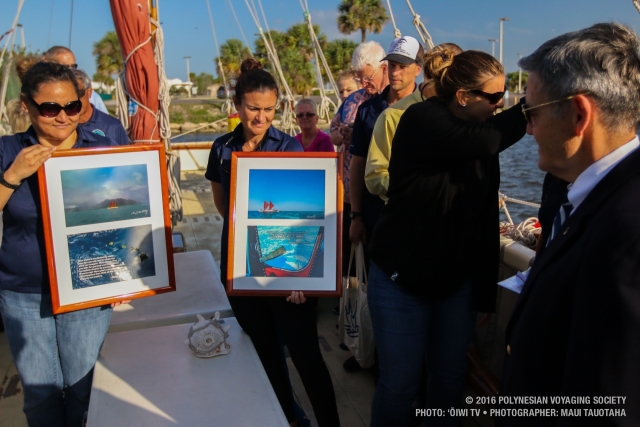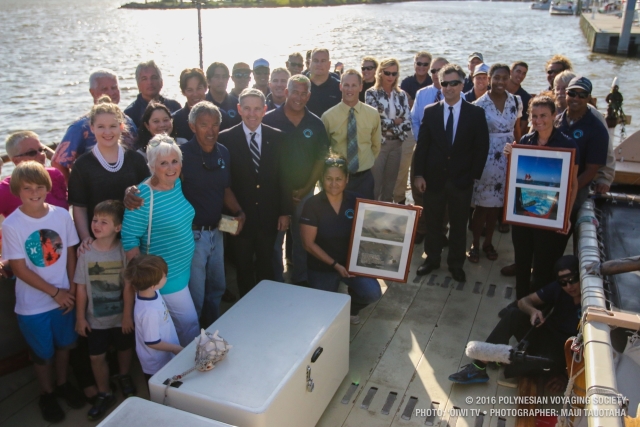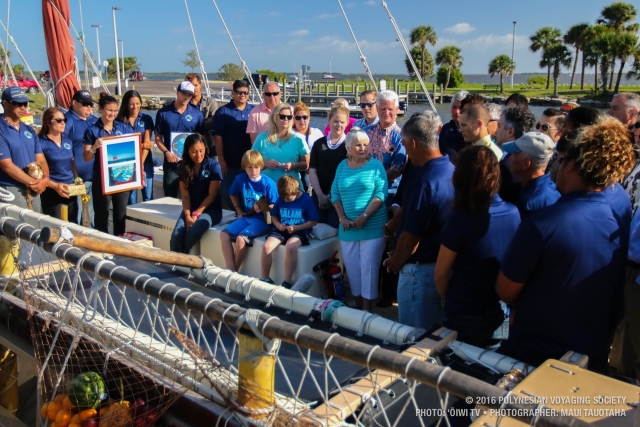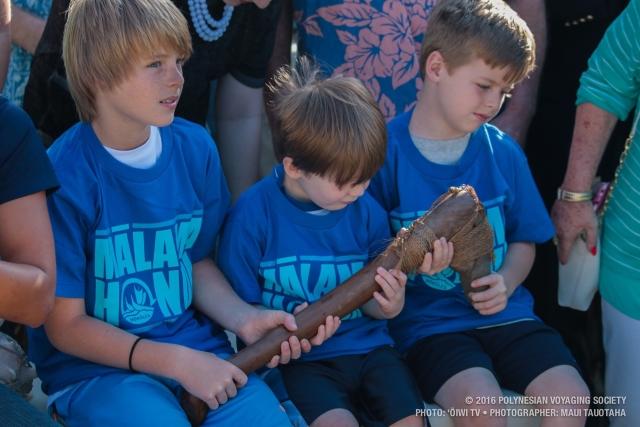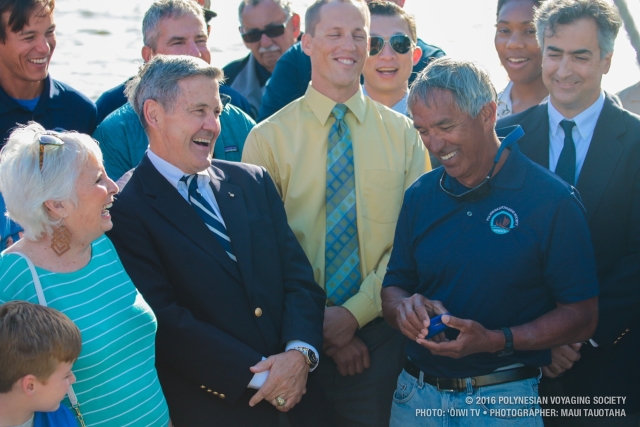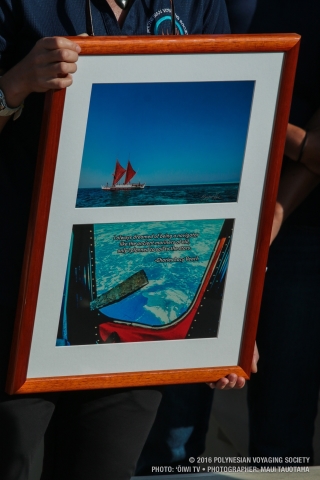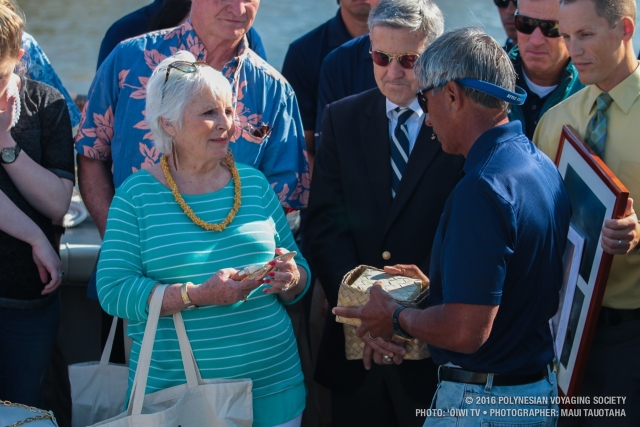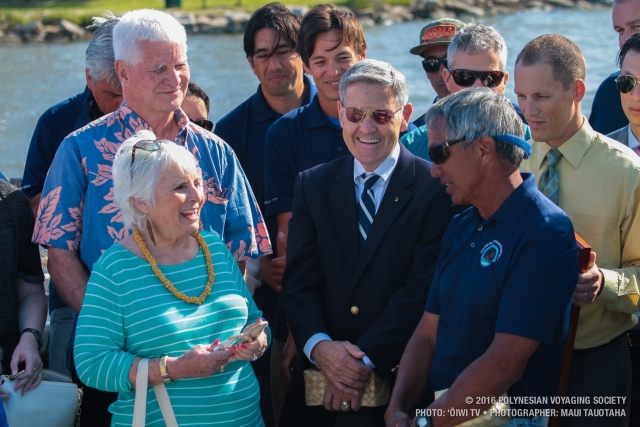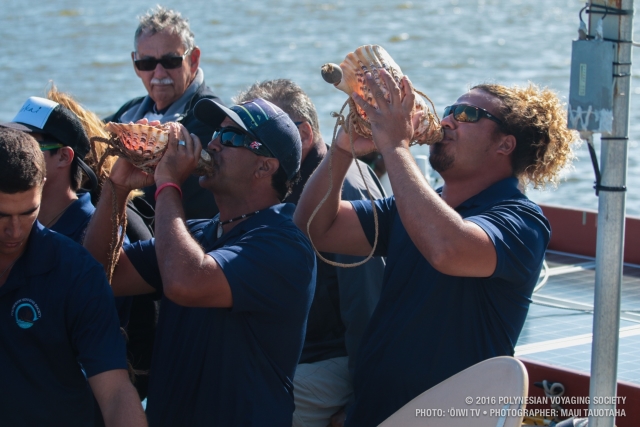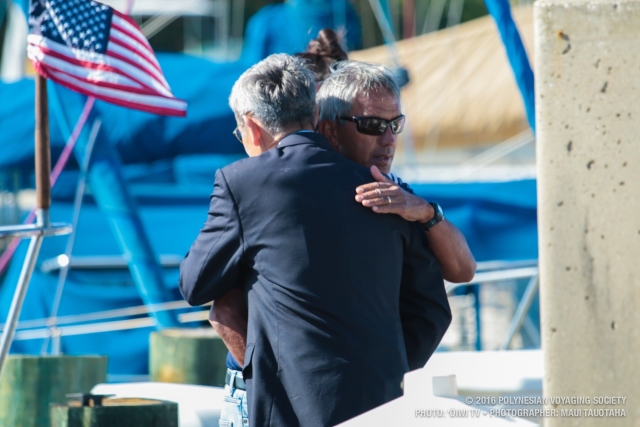
Worldwide Voyage | Honoring Lacy’s Legacy
- Posted on 29 Oct 2016
- In Featured, Newsletter, Photo Galleries, Teachers, Video Stories
After traveling to more than one hundred ports around the world, one of Hōkūleʻa’s first stops back in the United States was Florida to honor one of Hawaiʻi’s greatest explorers, Lacy Veach.
“The reason why we’re here is because of the inspiration of space and an amazing astronaut from Hawaiʻi,”says Nainoa Thompson, who is pwo navigator on Hōkūleʻa. “Lt. Colonel Lacy Veach, Hawaiʻiʻs second astronaut. The country needs to know that Lacy was the one that planted the idea as a seed to us in 1992 to take Hōkūleʻa around the world. So that’s foundational for us, Florida becomes foundational for for us.”
“It took us 22 years from the idea to actually leave, to get prepared, to build up the courage to do something as dangerous as what we’re doing. But I promised him I would go,” Thompson continues. “Coming to NASA for me has been an amazing celebration and humbly was the most important two days of this voyage for me, knowing that I kept a promise.”
The Hōkūleʻa crew was greeted by Lacy’s family in Florida’s Cape Canaveral where a ceremony was held in remembrance of his life’s mission especially as it relates to his connection and contribution to the waʻa.
Lacy’s Veach’s beloved wife, Alice Veach, found peace in this reunion as she felt Lacy’s presence. “When Lacy passed, I used to say, I need a sign. I need to know that you’re okay and I never got a sign until today and I really feel his spirit here with all of us.”
“Lacy would always go back to, ‘You have no idea how beautiful island earth is until you see the whole thing’.” Says Thompson. “How can you take care of something that you don’t understand right, Hōkūleʻa needs to know the earth, the earth needs to know Hōkūleʻa. He said, ‘Hawaiʻi needs to become the laboratory and the school to help us relearn how to live well on islands and that would be Hawaiʻi’s gift to the earth, it would be about peace.’ So that was the seed that he planted in our heads about responsibility.”
“Nainoa and Lacy shared such a unique friendship, they truly were soul mates and to be around them you could actually see this innate wisdom that they had and just what they thought the world could be a much better place,” reminisced Veach.
A friendship with a shared lifelong mission that Thompson recalls launched with a voyage back in 1992.
“We had a training sail, it was a Sunday morning and at 6:30 in the morning the Governor’s office calls and says, ‘Lieutenant Colonel Lacy Veach wants to sail with you today.’ Yikes! And so I told him, ‘Eh, tell him to come down at 9:00 a.m.’ and he comes driving down to pier 41, Lacy gets out of the car, ripped shorts, no shirt, no slippers, comes on the canoe! And I’ll never forget this. He rubbed the wood on Hōkūleʻa, on the rail with his hand and he goes, verbatim: ‘To all of you, thank you very very much, thank you so much for letting me come and sail on Hōkūleʻa today, cause today I’ll understand the definition of exploration’.”
From there they’ve seen the world through their own eyes, Nainoa as a captain leading explorations over the immense ocean and Lacy through unbounded space, yet their appreciation for home is what kept bringing them back together.
“By chance, by total chance we were coming back from Rarotonga on an average of about four knots, and by chance, he was in Columbia in 92,” says Thompson. “So he conjured up this plan with the Education department at NASA and hooked up a radio contact between the shuttle and Hōkūleʻa and so we talked about the comparisons between the past explorations and the future explorations.”
Thompson continues, “And then Lacy on that flight saw from the shuttle, says: ‘Nainoa, I have a present for you!’ So he he takes this stone, cropped the windows at the edge of the earth, Island of Hawaiʻi, the little red spot is Maunakea where the powerful telescopes live. Hawaiians would live up there to build adze, these adze were used to build voyaging canoes. That was the tool. That was the technology.”
“So he takes this adze up there and floats it in the window, ‘Here Nainoa, here’s a present’, he talks about three things: the power of remembering, the power of ancestral knowledge coupling with good science and technology, good science and technology and taking care of home. Lacy is our navigator on this voyage and for that, this is the most important two days for me. I’m not talking about a captain on the hill. I’m talking about from a personal point of view, from a best friend.”
“And it goes back to exactly what we want to do that Lacy would do to inspire children to find the way to the solutions that our generation couldn’t figure out. Give them the vehicles. Give them the tools.They need to be the navigators, they need to be the captain, they don’t need to be the bystanders of a changing world to somebody else’s vision. Our children need to be grounded in who they are and proud of who they are to be able to be willing to take on challenges like an education but at the same time, they need to couple that we need to couple that with science and technology, the things that will engineer our future and to make a better world.”
“The canoe, to me, it is a way of encouraging adults and youth alike to follow their dreams and to take care of this precious earth and to teach them ways in which they can take care of it because individually we can do it and together we can do more,” says Veach.
Help fund the Voyage as we sail the East Coast
Hōkūle‘a’s visit to the eastern United States is a historic milestone in her 40 years of voyaging.
Celebrate with us by pledging your support to the Mālama Honua Worldwide Voyage.


